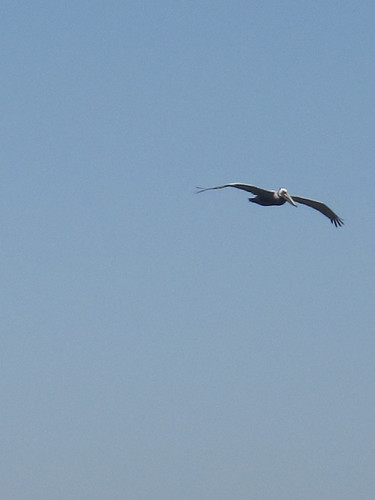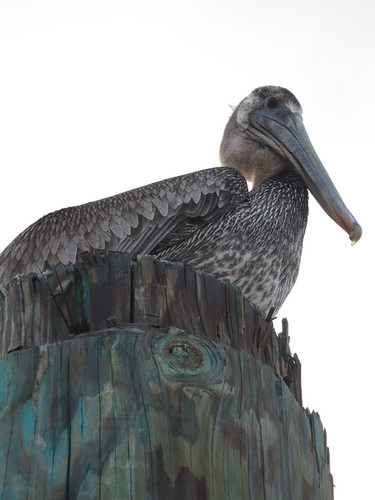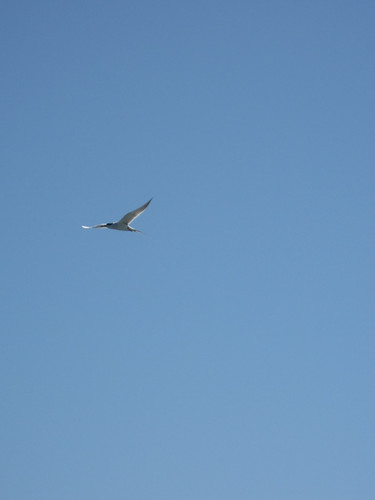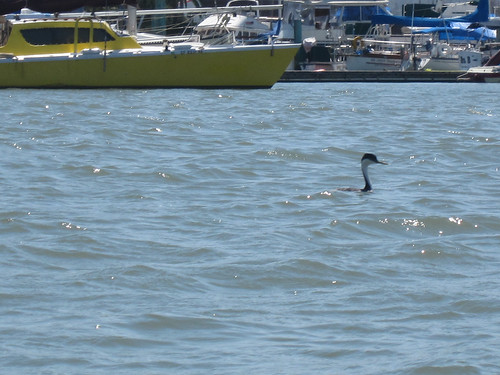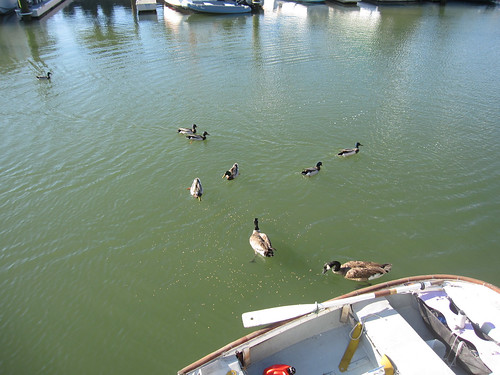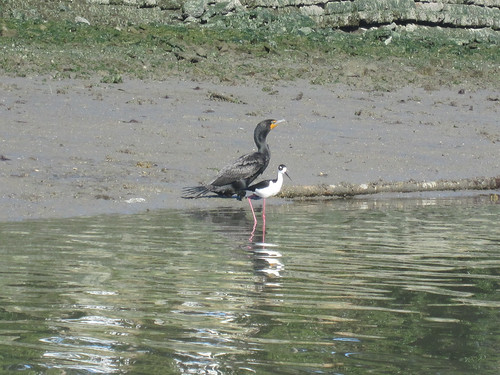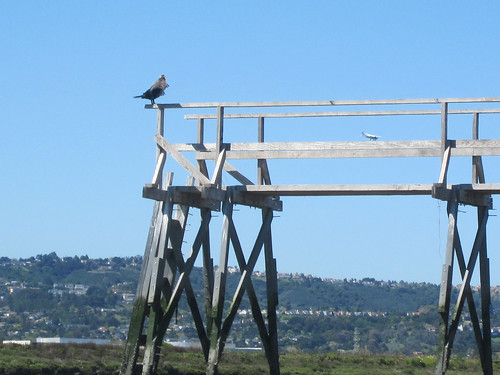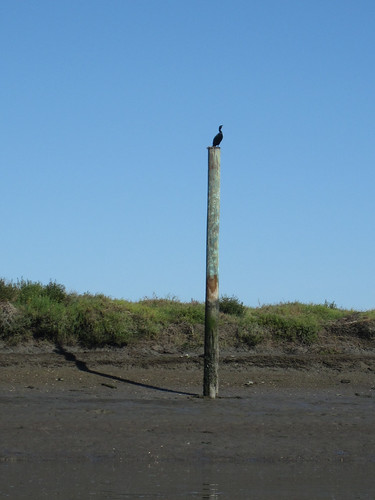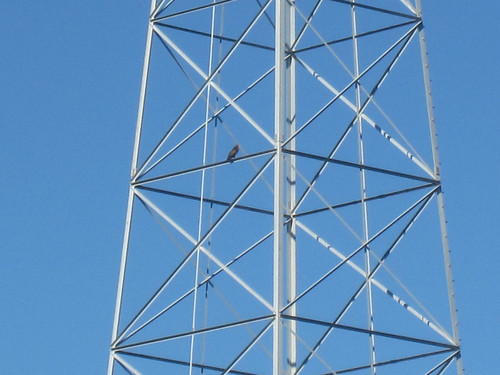Birds of Redwood Creek, Bair Island, and Smith Slough
I’ve been steadily exploring Redwood Creek and the slough around Bair Island from my houseboat in Pete’s Harbor, getting to know the birds of different seasons and the plant life as well as the patterns of wind and current. The human activity on the creek is mostly from tiny boats puttering around from Docktown to Pete’s Harbor to the city marina; tiny planes overhead on their way in and out of San Carlos airport; sailboats and crew and outrigger canoes from Bair Island Aquatic Center and the Stanford boathouse; and further downstream, the huge, fascinating, industrial Port of Redwood City.
I’ll start with the birds.
Brown Pelicans are fairly common. There were many living in the harbor itself over the winter, but they began to migrate elsewhere in the spring months. There’s always one or two out over Redwood Creek next to Bair Island, gliding and diving. They perch on pilings and sit on the floating docks near my boat, wary but tolerant of human approach. You’ve probably seen the heartbreaking photos of pelicans covered in oil from the BP oil spill in the Gulf of Mexico. Here’s some happy pelicans who live in Redwood City to cheer you up!
Terns, possibly more than one species of tern, showed up in mid-spring and are swooping over the harbor and river, catching tiny fish. They make a funny clicking noise almost like blue jays scolding. While I’m kayaking, terns fly right overhead and plunge into the water a foot or two from my boat. They’re incredibly graceful and a bit saucy. You can tell them from gulls a long way off from their swooping flight, black head, long beak, and curvy wings.
Great Blue Herons are a bit more rare. I see them most commonly in the early morning, evening, or far into Smith Slough away from the harbor itself. But they come into the harbor and hang out, even perching on dinghys and boat rails. When we see one, we stop paddling and glide as slowly as possible so as not to disturb it. They’re very shy.
Egrets are easy to spot all over the Bair islands, often visible from the Pete’s Harbor parking lots on Inner or Middle Bair or from the viewing trail. From the kayak, I most often see them in the tiny inlet we call “Pylon Bay”.
Western Grebes come right into the harbor, but they can almost always be found in a little flock next to Middle Bair Island right where the slough meets the creek, between Pete’s Harbor and the Marine Science Institute. They scatter when the crew boats row by in the early morning and evening. I’ve seen these grebes do the preliminary steps to their mating flights — pairing up and head pumping, copying each other, but not the full “walking on water” part. The grebes are everywhere in Redwood Creek and seem to be very successful in their fishing.
Coots are around, but less common in the creek. We have one resident coot who hangs around C and G Docks in the harbor, named Wacko by my neighbors. It hovers around the little flocks of ducks and sticks close to the shadows of the boats and docks during the day.
Ducks, seagulls, and small Canada Geese are extremely common around the harbor and Bair Island. I feed them (and Wacko the Coot) handfuls of duck chow in the evening from the back of my boat. A couple of weeks ago, I saw three pairs of Canada geese with 7 chicks, between the Bair view trail and Inner Bair Island, but the goose families with goslings haven’t come into the harbor. My neighbors have said that every year the ducks have lots of ducklings, most of which don’t make it to adulthood as they get eaten by herons and seagulls.
During a low tide, especially a minus tide, we see a lot of night herons. They’re very shy and wary, but they still perch on the docks to fish. It’s nice to see them out on the mudflats in a minus tide, along with phalaropes, plovers, peeps, black necked stilts, avocets, and what I think might be whimbrels. I love night herons because they look so fierce and grumpy.
I don’t have many photos of the avocets and stilts. I see them most often at the minus tides or way out in the slough. The closest point I expect to find stilts is in the slough in between Inner Bair and Middle Bair Island. Here’s a stilt right by Pete’s Harbor at a minus tide in the early morning, near the place we call Castle Point.
Cormorants are common and quite beautiful! They and the pelicans remind me of little dinosaurs. We recognize them a long way away from their low sleek profile sitting on the water, very different from the shape of a grebe, or from their characteristic posture perched on pilings, docks, or pylons, with wings outspread. The dock near the pylon across from the Pete’s Harbor laundry room, and the pylon itself by the Bair Island viewing trail, are pretty much guaranteed to be festooned with cormorants any time you look. I conclude that they must make a successful living from the creek and the area immediately around the harbor.
Red tailed hawks glide over Middle and Inner Bair Islands, hunting. Some small mammals must live there. A few years ago I saw rabbits boxing each other on Inner Bair, while it was still home to a hiking trail.
Though I haven’t seen a Clapper Rail, I’m pretty sure I’ve heard one over by Inner Bair Island: they sound like creaky machinery.
On Bair Island itself, there are swallows, red-winged blackbirds, finches, and other small songbirds I haven’t identified.
You can see quite a lot of these birds from the Bair Island viewing trail or from the Pete’s Harbor parking lot near the Waterfront Restaurant. To get to the viewing trail, get off Highway 101 at Whipple and go on Whipple towards the Bay, away from the city. You will pass some car dealerships and the old movie theater. The road curves around to the left, past the foot and bike bridge that goes across the creek to Main Street. Keep going past the Diving Pelican Cafe. Across from the Bair Island condos and a big empty field, just before the railing, road, and walkway that leads to the Pete’s Harbor ship on land that’s painted like the Italian flag, there is a tiny trail and a “Shore Access” sign. Park in the lot across the street from the trail.
Along the gravelled trail, there are two natural history signs that have information about the marsh. There are benches where you can sit to look out over the slough. If you walk about halfway down the trail towards Whipple, there is a tiny sand pit and playground good for toddlers to play in. Bikes can make it up this trail all the way to Whipple. Strollers are okay up until the halfway mark at the sand pit. It’s not very accessible for wheelchairs but not impossible if you can make it up the steep gravelled slope that starts the trail — I can make it only with a push from behind, but can do the trail after that despite the shallow gravel up until the sand pit. Past the sand pit, the trail is narrow and rough.
Leave a comment if you birdwatch around this area and let me know what you see!
